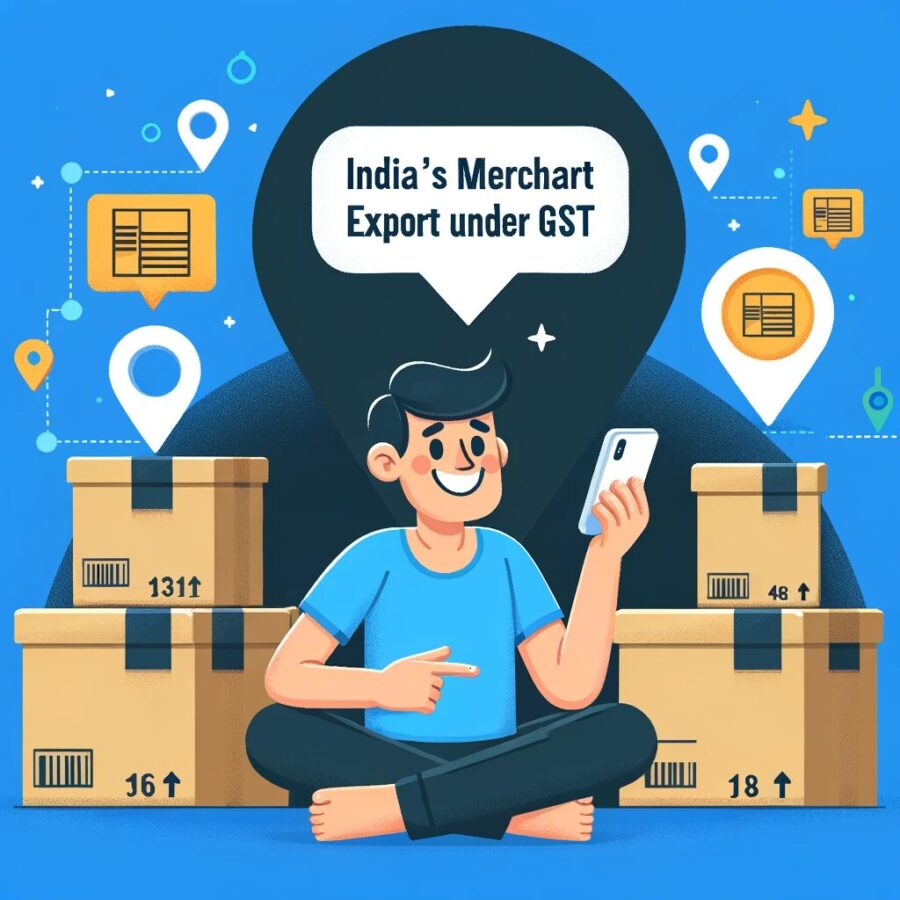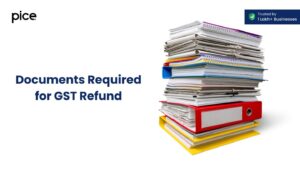India’s Merchant Exports Under GST
- 8 Aug 24
- 14 mins

India’s Merchant Exports Under GST
Key Takeaways
- Merchant Exports: Enable global trade without direct manufacturing, leveraging India's strengths.
- Merchant Exporter Role: Links Indian manufacturing with global markets, emphasizing compliance and logistics.
- Becoming an Exporter: This involves GST registration, market research, supplier partnerships, and logistics.
- Impact of GST: Exports are zero-rated, offering tax benefits and input tax credit refunds to exporters.
- GST Compliance: Requires registration, accurate record-keeping, timely returns, and thorough documentation.
Merchant exports refer to the export of goods by traders or entities that do not manufacture the items themselves. They instead buy goods from producers in their own country and sell them to customers in other countries. The idea is to let sellers reach customers all over the world without having to build factories.
Who is a merchant-exporter in India?
A merchant exporter is an individual or company engaged in the trade of exporting goods procured from domestic manufacturers to foreign markets.
Unlike manufacturer exporters, merchant exporters do not produce the goods themselves but act as intermediaries, adding value through logistics, packaging, and global market expertise

How Do You Become a Merchant Exporter in India?
Getting registered as a merchant exporter involves a lot of important steps, all of which are needed to start and run a successful business under the GST system.
Step 1: Obtain the Necessary Licenses and Registrations
Secure a GST registration and any other relevant licenses, such as an Import Export Code (IEC), from the Directorate General of Foreign Trade (DGFT).
Step 2: Understand the Market
Conduct market research to identify demand in target foreign markets and source domestic suppliers.
Step 3: Establish Connections with Suppliers
Build relationships with domestic manufacturers to source quality goods at competitive prices.
Step 4: Compliance and Documentation
Ensure compliance with GST and other regulatory requirements, and prepare necessary documentation.
Step 5: Logistics and Shipping
Arrange for logistics, including shipping and handling, to ensure the timely and safe delivery of goods to foreign buyers.
What is the role or activity of a merchant-exporter?
The role of a merchant-exporter extends beyond mere trading. They play a crucial role in promoting Indian goods in the international market, ensuring compliance with trade regulations, managing logistics, and navigating the complexities of international trade, thereby significantly contributing to the country's foreign exchange earnings.
Merchant Exports Under GST
The GST foundation has streamlined the tax implications for selling overseas, including merchant exports. Under GST, trade are treated as zero-rated supplies, allowing merchant exporters to claims refund on the input tax credit, thus reducing their cost of procurement and enhancing competitiveness.
Merchant export procedure under GST
- Registration and Compliance: Ensure GST registration and compliance with GST regulations.
- Documentation: Prepare accurate and comprehensive documentation, including GST invoices, shipping bills, and declarations.
- Filing Returns: File GST returns on time to claim input tax credits and refunds.
What are the provisions for merchant exporters under GST?
India's Goods and Services Tax (GST) brought big changes to taxes impacting trade, including merchant exports. The new system reduces what exporters pay for goods by letting them get tax money back faster as long as they trade the items within a few months
This refers to transactions where a seller (the merchant exporter) procures goods from a domestic supplier and trades them without substantial modification. Under GST, specific provisions have been made to support and promote merchant exports from India, ensuring that they remain competitive in the global market.
Under GST, merchant exports benefit from provisions such as the Export Promotion Capital Goods (EPCG) scheme, the Merchandise Exports from India Scheme (MEIS), and concessional applicable GST rate on inputs procured for trade. Here are the key provisions under GST:
- Zero-Rated Supply
Exports under GST are treated as zero-rated supplies. This means that goods or services exported (including merchant exports) are not subject to GST, allowing traders to improve their competitiveness in international markets.
- Refund of Input Tax Credit
Merchant exporters are eligible to claim refunds on the Input Tax Credit (ITC) for taxes paid on inputs and input services used in relation to goods exported. This keeps capital from being tied up in tax credits and helps exporters maintain enough cash flow.
- Concessional GST Rate benefits under Bond or LUT
Option to supply goods under bond or Letter of Undertaking (LUT) without payment of GST. Merchant exporters can supply goods procured for export without paying GST upfront, under the condition that the goods will be exported within a specified period (generally three months).
- Concessional GST Rate Relief for Procurement
Concessional GST rate for procurement of goods. A notable provision for merchant exporters is the availability of goods at a concessional GST rate of 0.1% from domestic suppliers for the purpose of trade.
By lowering procurement costs for merchant exporters, this provision helps, subject to conditions like providing a bond and promising to trade the goods within 90 days.
- LUT Facility
Facility to export under Letter of Undertaking (LUT). Qualified merchant exporters can trade goods or services without the payment of integrated tax by submitting an LUT, ensuring smoother cash flow management.
- Refund on Export of Goods
Fast-track refund process for exporters. The GST framework has provisions for a streamlined and expedited refund process for exporters, including merchant exporters, to claim refunds on their input tax credits, reducing the burden of taxes on trades.
- GST Compliance and Documentation
Simplified compliance and documentation. GST has simplified the documentation process for merchant exports by digitizing and integrating trade documents with the GST network, facilitating easier compliance and faster processing of refunds.
Benefits of merchant export under GST
Under the GST regime, merchant exporters benefit from the concessional tax rate on inter-state supply of goods, reducing the financial burden compared to regular rates.

GST provides benefits to Indian exports. With unified tax rates and simplified payment methods, Indian goods and services can compete better globally. The streamlined customs and production tax procedures under GST also help trade run smoothly and efficiently. This boosts how well Indian exports sell in international markets.
Eligibility for Concessional GST Rate
The eligibility for availing of the concessional GST rate for merchant exports is designed to promote trade while ensuring compliance with the Goods and Services Tax (GST) framework in India
Merchant exporters are eligible for a concessional GST rate of 0.1% on the procurement of goods from domestic suppliers for selling overseas purposes, provided they trade the goods within 90 days and fulfill other conditions prescribed under the GST laws.
Here are the key eligibility criteria for availing of the concessional GST rate for merchant exports:
- Valid Registration
GST Registration: Merchant exporters must be registered under GST to avail of the concessional rates. This is the primary requirement for accessing any benefits under the GST regime.
- Letter of Undertaking (LUT)
Submission of LUT: Exporters are required to furnish a Letter of Undertaking (LUT) to the GST authorities, committing to abide by the GST laws and regulations concerning trade. The LUT allows them to trade goods without paying IGST and is valid for the financial year in which it is submitted.
- Export Obligation
Export Within Specified Time: The goods procured at the concessional GST rate must be exported within a stipulated time frame, generally within 90 days from the date of invoice for the purchase. This ensures that the concessional rate is strictly used for the purpose of promoting trade.
- Bond or Security
Furnishing of Bonds for Export: In certain cases, merchant exporters may be required to furnish a bond in lieu of the LUT, along with a security or bank guarantee. This serves as security to ensure compliance with the trade obligation.
- Documentation and Compliance
Accurate Documentation: Proper documentation, including the purchase invoice indicating the concessional rate of GST, shipping bills, and trade documentation, must be maintained. These documents serve as proof of trade and are essential for compliance and audit purposes.
- Reporting and Reconciliation
Regular Reporting: Exporters must report these transactions in their monthly GST returns accurately. This includes details of the goods exported, GST paid at concessional rates, and proof of trade.
- No Supply in Domestic Market
Restriction on Domestic Supply: Goods procured at the concessional GST rate are strictly for trade purposes and should not be supplied in the domestic market. Any deviation from this condition may lead to the revocation of the concessional rate and imposition of penalties.
How do I claim refunds under merchant exports in India?
Claiming refunds under merchant exports is an important aspect of the Goods and Services Tax (GST) regime in India, allowing exporters to maintain liquidity by recovering the taxes paid on inputs.

Refunds under merchant exports can be claimed by filing the relevant forms and providing documentation proving that the goods have been exported. This includes shipping bills, tax invoices, and proof of realization of trade proceeds.
Here’s a step-by-step guide on how to claim refunds under merchant exports:
Step 1: Understand the Types of Refunds Available
Under GST, merchant exporters can claim two main types of refunds:
- Refund of Integrated Goods and Services Tax (IGST) paid on exports: applicable when goods are exported on payment of IGST.
- Refund of input tax credit (ITC) for inputs/input services used in the production of exported goods: When goods are exported under a bond or Letter of Undertaking (LUT) without payment of IGST, exporters can claim a refund of the ITC on inputs used.
Step 2: Ensure Compliance with GST Regulations
Before filing for a refund, ensure that all GST returns are filed correctly and on time. Compliance with GST laws and accurate reporting of trade transactions in returns are prerequisites for a smooth refund process.
Step 3: Gather the Necessary Documents
Prepare the necessary documentation to support your refund claim, including:
- GST invoices for input and input services
- Shipping bills or bills of export
- Export General Manifest (EGM)
- Bank Realization Certificate (BRC) or Foreign Inward Remittance Certificate (FIRC) to prove receipt of payment in convertible foreign exchange
- Any other documents as prescribed under GST laws
Step 4: File the Refund Application
Refund of IGST: The refund claim for IGST paid on trade is processed automatically based on the shipping bill and tax invoice details furnished in the GST returns. Ensure that the shipping bill details are correctly mentioned in the GSTR-1.
Refund of Input Tax Credit: To claim a refund of ITC, file Form GST RFD-01 on the GST portal. The application should be filed within two years from the relevant date, which is usually the date of the shipping bill or bill of export.
Step 5: Provide a Statement of Invoice
Along with the refund application, provide a statement of invoices of inputs and input services used in the goods exported. This statement is crucial for processing the ITC refund and should match the details furnished in the GST returns.
Step 6: Follow Up and Rectify errors, if Any
After submitting the refund application, monitor its status through the GST portal. If there are any discrepancies or errors, the GST authorities may issue a deficiency memo, and you will have an opportunity to rectify the errors and resubmit the application.
Step 7: Refund Sanction and Payment
Once the application is processed and approved, the refund amount will be credited to the bank account specified in the refund application. The process typically takes up to 60 days from the date of application submission, provided all conditions are met and documentation is in order.
Additional Tips
- Maintain clear records of all transactions related to exports, including procurement of inputs, production of exported goods, and shipping.
- Staying updated with any changes to GST laws and return processes is important to make sure you follow the rules and avoid delays in processing your refund.
- Leverage professional advice, if necessary, to navigate the refund process efficiently.
Merchant Export Scheme for Exporters?
The Indian government's strategic move to promote trade operations and help Indian exporters stay competitive and grow their presence in international markets is the Merchant Export Scheme under the Goods and Services Tax.
By reducing financial issues and expediting tax procedures, the project facilitates merchant export growth and improves the country's economy.

Concessional GST Rate for Procurement
Purchasing products at a reduced GST rate of 0.1% for commercial purposes is one of the main characteristics of the Merchant Export Scheme. For merchant exporters, who usually have to purchase items from local producers and then trade them, this drastically lowers the cost of procurement.
Benefits of the Scheme
- Reduced Cost of Procurement: The initiative helps exporters manage their cash flow by lowering their upfront tax costs by permitting procurement at a concessional GST rate.
- Competitiveness: The reduction in procurement costs translates into more competitive pricing for Indian goods in the international market.
- Simplified Tax Refunds: The program lessens the financial burden on exporters by streamlining the process of requesting refunds on the input tax credit for taxes paid on inputs used in the export of products.
GST Rate Update for Merchant Export Scheme
The GST Council periodically reviews and updates GST rates, including those applicable to merchant exports, to reflect economic and policy changes. Recent changes have focused on simplifying the tax structure and reducing rates for exporters to encourage foreign trade.
Conclusion
India's economy depends heavily on merchant exports since they serve as a conduit between local producers and overseas consumers. The Goods and Services Tax (GST) system has resulted in notable modifications, facilitating trade and offering benefits such as lower rates and input tax credits.
💡If you want to streamline your merchant export activities under GST and make GST payments, consider using the PICE App. Explore the PICE App today and take your export business to new heights.
FAQs
What GST rate applies to merchant exports?
How do export promotion schemes under GST benefit merchant exporters?
Under GST, export promotion schemes like the Export Promotion Capital Goods (EPCG) scheme and the Merchandise Exports from India Scheme (MEIS) help merchant exporters by letting them bring in goods needed for export production duty-free, giving them subsidies, and letting them sell goods under a bond or Letter of Undertaking (LUT) without having to pay GST. These schemes aim to enhance the global competitiveness of Indian exports by reducing the cost of production and facilitating the refund of input taxes.
What documentation is required for GST-compliant merchant exports?
For GST-compliant merchant exports, the required documentation includes a tax invoice, a shipping bill/bill of export, a Letter of Undertaking (LUT) to export goods or services without payment of IGST, and proof of receipt of foreign currency. Additionally, exporters must provide details of the goods being exported in their GST returns to claim refunds on input taxes. Proper documentation ensures compliance and facilitates the smooth processing of exports and tax refunds.
How can technology facilitate GST compliance for merchant exporters?
Technology can facilitate GST compliance for merchant exporters through automated GST software that simplifies invoice generation, tax filing, and refund claims. Integrated systems can track shipments, manage export documentation, and ensure accurate tax calculations. Additionally, digital platforms offer real-time access to GST updates and notifications, helping exporters stay compliant with changing regulations and streamline their tax processes efficiently.
What are the key risks for merchant exporters under GST, and how can they be mitigated?
How do international trade agreements impact merchant exporters?
International trade agreements impact merchant exporters by reducing tariffs, simplifying customs procedures, and providing access to new markets. These agreements can enhance the competitiveness of exporters by lowering the cost of exporting goods and services. Compliance with the rules of origin and other requirements stipulated in these agreements is crucial for exporters to benefit from the preferential treatment offered.
What sustainable practices can merchant exporters adopt to enhance their global competitiveness?
Merchant exporters can enhance their global competitiveness through sustainable practices such as adopting eco-friendly packaging, optimizing logistics for lower carbon emissions, and ensuring their supply chains uphold environmental and social standards. Implementing such practices not only reduces environmental impact but also meets the increasing demand from global consumers and retailers for sustainable and ethically produced goods, opening up new market opportunities.
 By
By 
















